

Australia's pearling industry. The pearling industry was a major economic force for over one hundred years in northern Australia and for business interests in the southern capitals from the 1850s onwards.
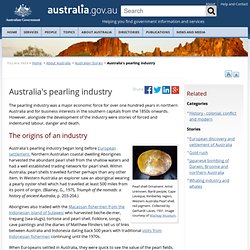
However, alongside the development of the industry were stories of forced and indentured labour, danger and death. The origins of an industry Pearl shell Ornament. Artist unknown. Bardi people, Cape Leveque, Kimberley region, Western Australia Pearl shell, red pigment. Australia's pearling industry began long before Northern Australian coastal dwelling Aborigines harvested the abundant pearl shell from the shallow waters and had a well established trading network for pearl shell.
Aborigines also traded with the who harvested beche-de-mer, trepang (sea-slugs), tortoise and pearl shell. Afghan cameleers in Australia. By the mid-1800s, exploration in Australia was at its peak with expeditions setting out almost monthly.
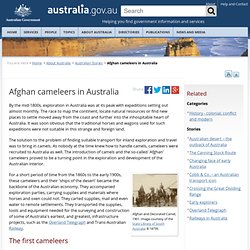
The race to map the continent, locate natural resources or find new places to settle moved away from the coast and further into the inhospitable heart of Australia. It was soon obvious that the traditional horses and wagons used for such expeditions were not suitable in this strange and foreign land. The solution to the problem of finding suitable transport for inland exploration and travel was to bring in camels. As nobody at the time knew how to handle camels, cameleers were recruited to Australia as well. The Macarthurs and the merino sheep. Australia is the largest wool-producing country in the world.

We have tens of thousands of wool producing properties and production of this fibre is one of the most significant and important uses of our farm land. Our consistently accounts for over one quarter of the world's wool and is often valued at well over $2 billion each year. Australia is also recognised as producing the world's highest quality woollen fibre – Australian merino wool. The Overland Telegraph. For the early settlers, Australia was a harsh and unforgiving land.
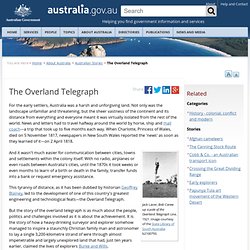
Not only was the landscape unfamiliar and threatening, but the sheer vastness of the continent and its distance from everything and everyone meant it was virtually isolated from the rest of the world. News and letters had to travel halfway around the world by horse, ship and —a trip that took up to five months each way. When Charlotte, Princess of Wales, died on 5 November 1817, newspapers in New South Wales reported the 'news' as soon as they learned of it—on 2 April 1818. The Australian National Anthem. Loui Seselja, Portrait of Margret Roadknight, singer, looking at sheet music for Waltzing Matilda while visiting the National Library of Australia, Music Section, Canberra, 22 July 1994, negative: b&w.
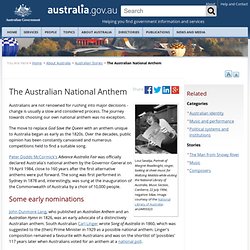
Image courtesy of the : an24493323 Australians are not renowned for rushing into major decisions - change is usually a slow and considered process. The journey towards choosing our own national anthem was no exception. The move to replace God Save the Queen with an anthem unique to Australia began as early as the 1820s.
Over the decades, public opinion has been constantly canvassed and numerous competitions held to find a suitable song. Advance Australia Fair was officially declared Australia's national anthem by the Governor-General on 19 April 1984, close to 160 years after the first alternative anthems were put forward. Some early nominations , who published an Australian Anthem and an Australian Hymn in 1826, was an early advocate of a distinctively Australian anthem. A new anthem. Eureka Stockade. Chinatowns across Australia. Chinatowns developed in Australia as a result of the large influx of Chinese migrants, which was driven by a system of indentured labour and then the gold rushes of the 1850s.

The changing face of modern Australia. Italian workers at a knitting factory.

Image courtesy of the . The hundreds of thousands of people who arrived in Australia after the First World War greatly influenced Australia becoming a modern society. They brought with them skills, commitment to family, education and their own cultural values. Their experiences in Australian created new ways of eating in cafés and milk bars, new public buildings, new approaches to leisure, new concepts of and and new sounds - . The years between the First and Second World Wars saw the emergence of cultural diversity in Australian society that was characterised by a expanded migration of people, especially men from southern Europe, the Adriatic and the Mediterranean. The 1920s and 1930s were hard times with a Depression that saw massive unemployment, poverty and hardship. Australia's involvement in the Allied forces in Europe in the war against Nazi Germany created a compassion for displaced persons in Europe.
The Australian gold rush. JCF Johnson, A Game of Euchre, col. wood engraving, Australasian Sketcher Supplement [Melbourne], 25 December, 1876.

Migrants. As the Scheme progressed, men from all over the world converged on the Snowy like pilgrims, prepared to ride the hardships in return for a new life.
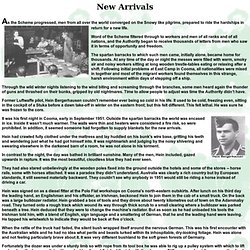
Word of the Scheme filtered through to workers and men of all ranks and of all nations, and the Authority began to receive thousands of letters from men who saw it in terms of opportunity and freedom. The spartan barracks to which such men came, initially alone, became home for thousands. At any time of the day or night the messes were filled with warm, smoky air and noisy workers sitting at long wooden trestle-tables eating or relaxing after a shift. Following initial problems at East Camp in Cooma, all nationalities were mixed in together and most of the migrant workers found themselves in this strange, harsh environment within days of stepping off a ship.
Former Luftwaffe pilot, Hein Bergerhausen couldn't remember ever being so cold in his life. It was his first night in Cooma, early in September 1951. Five o'clock passed.